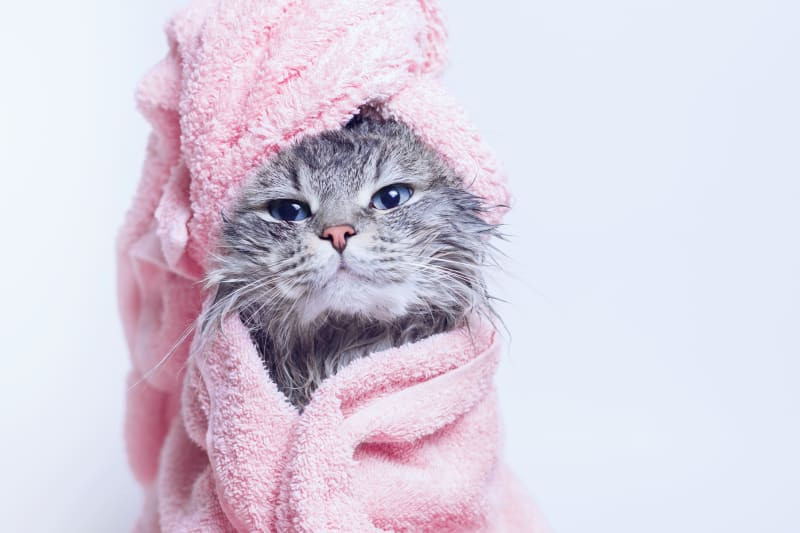Are you wondering, “Am I Supposed To Bathe My Cat?” Absolutely! While cats are known for their self-grooming habits, occasional baths are still necessary for their overall health and hygiene. At solcat.net, we understand the nuances of feline care, and we’re here to guide you through the process with expert advice on cat grooming, feline hygiene, and maintaining a healthy cat coat.
1. Understanding Your Cat’s Hygiene Needs
1.1 Do Cats Really Need Baths?
Yes, cats benefit from occasional baths. While cats are meticulous groomers, using their tongues to spread saliva and natural oils, they can’t always remove all debris or address specific skin conditions. According to the Cornell Feline Health Center, even the most diligent self-groomers sometimes require assistance to maintain optimal hygiene.
 Cat grooming itself with its tongue
Cat grooming itself with its tongue
1.2 How Often Should You Bathe Your Feline Friend?
The frequency of baths depends on several factors, including breed, lifestyle, and health conditions. Generally, most cats need a bath every 4-6 weeks. However, long-haired breeds may benefit from more frequent bathing (closer to every 4 weeks) to prevent matting and dirt buildup. Hairless breeds like the Sphynx require weekly baths because they lack fur to absorb skin oils.
- Normal-coated cats: Every 4-6 weeks
- Long-haired cats: Every 4 weeks
- Hairless cats: Weekly
1.3 Special Circumstances Requiring Baths
Certain situations necessitate more frequent or immediate baths:
- Exposure to harmful substances: If your cat gets into oil, grease, or other potentially toxic substances, a bath is crucial.
- Skin conditions: Cats with seborrhea or other skin issues may require medicated baths, as recommended by your veterinarian.
- Age or weight: Older or overweight cats may struggle with self-grooming and need extra help.
2. Preparing for Bath Time: A Step-by-Step Guide
2.1 Gathering Your Supplies
Before you even think about getting your cat near water, assemble everything you’ll need:
- Cat shampoo: Always use shampoo specifically formulated for cats. Human shampoo can irritate their skin. Consult your vet for recommendations.
- Towels: Have several large, soft towels ready.
- Handheld showerhead or pitcher: This makes rinsing easier and more controlled.
- Non-slip mat: Place this in the tub or sink to provide traction.
- Brush: A good brushing before the bath removes mats and loose fur.
2.2 Pre-Bath Preparations: Setting the Stage for Success
- Trim nails: A preemptive nail trim can save you from scratches.
- Brush your cat: This removes loose fur and mats, making the bath more effective.
- Choose the right time: Pick a time when your cat is relaxed, perhaps after a meal or play session.
- Warm water: Ensure the water is lukewarm, not too hot or cold.
- Calm environment: Keep the bathroom quiet and free from distractions.
2.3 Introducing Your Cat to the Bathroom Environment
If your cat is anxious about water, acclimate them to the bathroom gradually. Take them in while the water is running, allowing them to explore without forcing them into the tub. This helps them become accustomed to the sounds and smells.
3. The Bathing Process: A Gentle Approach
3.1 Getting Your Cat Wet
Gently place your cat in the tub or sink. Use a handheld showerhead or pitcher to wet their fur, avoiding the face and ears. Speak calmly and offer praise to reassure them.
3.2 Applying Shampoo and Conditioning
Apply a small amount of cat shampoo to their wet fur. Gently massage the shampoo, working from head to tail. Be thorough but avoid getting shampoo in their eyes and ears. If required, follow with a cat-specific conditioner.
3.3 Rinsing Thoroughly
Rinse all traces of shampoo and conditioner from your cat’s fur. Residue can cause skin irritation. Use the handheld showerhead or pitcher to ensure a thorough rinse.
3.4 Drying Off: Towel and Hair Dryer Options
Wrap your cat in a towel and gently pat them dry. If your cat tolerates it, you can use a hair dryer on a low, cool setting. Be careful not to overheat them or scare them with the noise.
 Woman drying a cat with a towel
Woman drying a cat with a towel
4. Dealing with Difficult Cats: Tips and Tricks
4.1 Minimizing Stress and Anxiety
- Stay calm: Cats sense anxiety. Project a calm, confident demeanor.
- Use treats: Reward your cat with treats throughout the process.
- Enlist help: Having a friend assist can make the process easier and safer.
- Positive reinforcement: Praise and reassure your cat constantly.
4.2 Alternative Bathing Methods
If your cat is extremely resistant to water, consider these alternatives:
- Spot cleaning: Use a damp cloth to clean specific areas.
- Waterless shampoo: These foams or sprays can be applied and towel-dried.
- Professional groomer: Sometimes, it’s best to leave it to the experts.
4.3 What to Do If Your Cat Scratches or Bites
If your cat becomes aggressive, prioritize your safety. Wrap them in a towel to restrain them and end the bath. Consult with a veterinarian or behaviorist for advice on managing their behavior.
5. Specific Cat Breeds and Their Bathing Needs
5.1 Long-Haired Breeds (e.g., Persians, Maine Coons)
These breeds require frequent brushing and bathing to prevent matting. Use a high-quality shampoo and conditioner to maintain their luxurious coats.
5.2 Short-Haired Breeds (e.g., Siamese, American Shorthair)
Short-haired cats generally need less frequent bathing. Focus on regular brushing to remove loose fur and maintain their coat’s shine.
5.3 Hairless Breeds (e.g., Sphynx)
Hairless cats need weekly baths to remove oil buildup on their skin. Use a gentle, hypoallergenic shampoo to avoid irritation.
6. Skin Conditions and Bathing: What You Need to Know
6.1 Seborrhea
Seborrhea is a skin disorder that causes flaky, red, and itchy skin. Medicated baths with special shampoos can help manage this condition.
6.2 Allergies
Cats can have allergies that cause skin irritation. Hypoallergenic shampoos and regular bathing can alleviate symptoms.
6.3 Ringworm
Ringworm is a fungal infection that requires medicated baths. Follow your veterinarian’s instructions carefully.
6.4 Fleas
Flea shampoos can help eliminate fleas. However, they should be used in conjunction with other flea control measures.
7. Choosing the Right Cat Shampoo
7.1 Key Ingredients to Look For
- Hypoallergenic: Ideal for cats with sensitive skin.
- Oatmeal: Soothes itchy skin.
- Aloe vera: Moisturizes and heals.
- Essential oils: Some essential oils, like lavender, can have calming properties (ensure they are safe for cats).
7.2 Ingredients to Avoid
- Sulfates: Can strip the coat of natural oils.
- Parabens: Potential endocrine disruptors.
- Artificial fragrances: Can cause allergic reactions.
- Human shampoos: Too harsh for cat skin.
7.3 Veterinarian Recommendations
Consult your vet for specific shampoo recommendations based on your cat’s individual needs and any existing skin conditions.
8. Advanced Grooming Techniques
8.1 Nail Trimming
Regular nail trims prevent overgrowth and reduce the risk of scratching. Use cat-specific clippers and avoid cutting too close to the quick (the pink part of the nail).
8.2 Ear Cleaning
Clean your cat’s ears regularly with a veterinarian-approved ear cleaning solution. Use a cotton ball to gently wipe away any debris.
8.3 Teeth Brushing
Brushing your cat’s teeth helps prevent dental disease. Use a cat-specific toothbrush and toothpaste.
8.4 Anal Gland Expression
Some cats require occasional anal gland expression. If you’re unsure how to do this, consult your veterinarian.
9. Common Mistakes to Avoid When Bathing Your Cat
9.1 Using Human Shampoo
Human shampoo is too harsh for cats and can cause skin irritation. Always use a shampoo specifically formulated for cats.
9.2 Getting Water in the Ears
Water in the ears can lead to infections. Use cotton balls to protect your cat’s ears during the bath.
9.3 Forgetting to Brush Before Bathing
Brushing before bathing removes mats and loose fur, making the bath more effective.
9.4 Rushing the Process
Rushing can stress your cat and make the experience unpleasant. Take your time and be gentle.
9.5 Not Drying Your Cat Properly
Leaving your cat wet can lead to chills and discomfort. Dry them thoroughly with a towel or hair dryer on a low, cool setting.
10. The Benefits of Professional Grooming
10.1 Expertise and Experience
Professional groomers have the expertise and experience to handle even the most difficult cats.
10.2 Specialized Equipment and Products
Groomers use specialized equipment and products to achieve the best results.
10.3 Stress-Free Experience
For some cats, professional grooming is less stressful than bathing at home.
10.4 Identifying Potential Health Issues
Groomers can identify potential skin or coat problems and alert you to any concerns.
11. Research-Backed Insights on Feline Grooming
According to a study published in the Journal of Feline Medicine and Surgery, regular grooming, including bathing when necessary, can significantly improve a cat’s coat health and overall well-being. The study emphasized the importance of using cat-specific products and gentle techniques to minimize stress.
12. Real-Life Scenarios and Solutions
12.1 My Cat Hates Water
If your cat is terrified of water, try spot cleaning or waterless shampoo. Gradually acclimate them to the bathroom environment and use positive reinforcement.
12.2 My Cat Has Matted Fur
Matted fur can be painful and difficult to remove. Consult a professional groomer for assistance.
12.3 My Cat Has Dry Skin
Use a moisturizing shampoo and consider adding omega-3 fatty acids to your cat’s diet.
13. DIY Cat Spa Day: Creating a Relaxing Experience
13.1 Setting the Mood
Create a relaxing atmosphere with soft music, dim lighting, and a comfortable temperature.
13.2 Gentle Massage
Massage your cat gently to relax their muscles and improve circulation.
13.3 Calming Scents
Use calming scents like lavender (ensure it’s safe for cats) to create a spa-like atmosphere.
14. Staying Up-to-Date with Feline Grooming Trends
14.1 New Products on the Market
Stay informed about new cat shampoos, conditioners, and grooming tools.
14.2 Emerging Grooming Techniques
Learn about new grooming techniques and best practices.
14.3 Feline Health Studies
Keep up with the latest research on feline health and grooming.
15. The Importance of Positive Reinforcement
15.1 Rewarding Good Behavior
Reward your cat with treats, praise, and affection for tolerating the bathing process.
15.2 Creating a Positive Association
Associate bathing with positive experiences to reduce stress and anxiety.
15.3 Building Trust
Building trust with your cat is essential for successful grooming.
16. The Long-Term Benefits of Regular Grooming
16.1 Healthier Coat and Skin
Regular grooming promotes a healthier coat and skin.
16.2 Reduced Hairballs
Grooming removes loose fur, reducing the risk of hairballs.
16.3 Early Detection of Health Issues
Grooming allows you to detect potential health issues early.
16.4 Stronger Bond with Your Cat
Grooming strengthens the bond between you and your cat.
17. Addressing Common Myths About Cat Bathing
17.1 Cats Don’t Need Baths
While cats groom themselves, they still benefit from occasional baths.
17.2 Bathing Is Always Stressful for Cats
With the right techniques, bathing can be a positive experience for cats.
17.3 All Shampoos Are the Same
Cat-specific shampoos are formulated to be gentle on their skin.
18. Resources and Further Reading
18.1 Cornell Feline Health Center
The Cornell Feline Health Center is a valuable resource for feline health information.
18.2 American Animal Hospital Association (AAHA)
AAHA provides resources and guidelines for pet care.
18.3 Local Veterinarians and Groomers
Consult with local veterinarians and groomers for personalized advice.
19. FAQs: Your Cat Bathing Questions Answered
19.1 Is It Okay to Use Baby Shampoo on My Cat?
No, baby shampoo is not recommended for cats. It can still be too harsh and may contain ingredients that are harmful to them.
19.2 Can I Use Dawn Dish Soap to Bathe My Cat?
While Dawn dish soap is sometimes recommended for removing oil from wildlife, it’s not ideal for regular cat bathing. It can strip their coat of natural oils and cause dryness.
19.3 How Do I Get Rid of Fleas on My Cat?
Use a flea shampoo specifically formulated for cats, along with other flea control measures recommended by your veterinarian.
19.4 My Cat Is Shedding Excessively. What Should I Do?
Regular brushing and a balanced diet can help reduce shedding. Consult your veterinarian to rule out any underlying health issues.
19.5 How Can I Prevent Hairballs in My Cat?
Regular grooming, a high-fiber diet, and hairball remedies can help prevent hairballs.
19.6 What Are the Signs of a Skin Infection in Cats?
Signs include redness, itching, hair loss, and scaly skin. Consult your veterinarian for diagnosis and treatment.
19.7 Can I Use Essential Oils in My Cat’s Bath?
Some essential oils are toxic to cats. Only use essential oils that are specifically formulated and safe for cats, and consult with your veterinarian first.
19.8 How Often Should I Brush My Cat’s Teeth?
Ideally, you should brush your cat’s teeth daily. However, even brushing a few times a week can make a difference.
19.9 What Are the Benefits of a Waterless Cat Shampoo?
Waterless shampoos are a convenient option for spot cleaning or for cats who dislike water. They can help freshen up the coat without the need for a full bath.
19.10 How Do I Know If My Cat Needs to See a Veterinarian for a Skin Problem?
If your cat has persistent skin issues, such as redness, itching, hair loss, or open sores, it’s important to consult with your veterinarian for diagnosis and treatment.
20. Join the Solcat.net Community
20.1 Share Your Experiences
Share your cat bathing tips and experiences with the solcat.net community.
20.2 Ask Questions and Get Advice
Get answers to your cat care questions from our expert community.
20.3 Stay Informed
Stay up-to-date with the latest feline health and grooming information.
Bathing your cat doesn’t have to be a stressful experience. With the right preparation, techniques, and products, you can keep your feline friend clean, healthy, and happy. Remember to visit solcat.net for more expert advice, tips, and resources on all things cat-related. Need more personalized advice? Contact us at 950 Alaskan Way, Seattle, WA 98104, United States, or call +1 (206) 386-4000.


